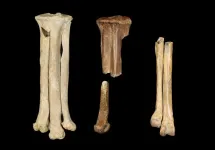(Press-News.org) Cerebral adrenoleukodystrophy (CALD) is a rare progressive, genetic brain disease that primarily presents in young boys, causing loss of neurological function and ultimately leading to early death. Researchers from Massachusetts General Hospital, a founding member of the Mass General Brigham healthcare system, Boston Children’s Hospital, and collaborators have shown that six years after treatment with the first gene therapy approved for CALD, 94 percent of patients have had no decline in neurological functioning, with over 80 percent remaining free of major disability. Findings, published in two articles in the New England Journal of Medicine, describe long-term outcomes in those treated with the eli-cel gene therapy, while also highlighting safety concerns about the emergence of blood cancers post-treatment.
“Cerebral adrenoleukodystrophy is a devastating brain disease that strikes children in the prime of their childhood and development,” said Florian Eichler, MD, director of the Leukodystrophy Clinic in the Department of Neurology at Massachusetts General Hospital, first author of the paper on long-term outcomes. “When I initially began treating patients with CALD, 80 percent came into our clinic on death’s door, and now the ratio has flipped. We cautiously celebrate that we have been able to stabilize this neurologic disease and give these boys back a fulfilling life, but that jubilation is dampened by the fact that we see malignancy in a subset of these patients. This is something that we are actively trying to understand and address.”
In 2022, the U.S. Food and Drug Administration approved the first gene therapy for CALD, elivaldogene autotemcel (eli-cel), which was clinically evaluated by the researchers from Mass General and Boston Children’s Hospital. In the new study, 32 boys aged 3 to 13 years with early-stage CALD received eli-cel as part of the ALD-102 trial, which was sponsored by bluebird, bio, Inc., the company that developed the therapy.
The therapy uses a Lenti-D lentiviral vector to add a healthy copy of the ABCD1 gene, which is faulty in those with CALD, to blood stem cells that have been removed from the patient. These stem cells are then reintroduced to the patient via an autologous hematopoietic stem cell transplantation (HSCT). Using a patient’s own cells substantially reduces the risk of graft-versus host disease—a risk posed by other forms of treatment.
In the ALD-102 trial, one patient developed a condition known as myelodysplastic syndrome (MDS) with excess blasts, a hematologic malignancy that appears to have been triggered by the Lenti-D lentiviral vector used to deliver the gene therapy. In a second, more recent trial of the eli-cel therapy (ALD-104), six of 35 patients have developed a hematologic malignancy (MDS in five patients and acute myeloid leukemia in one) which appear to be also caused by the vector. These results were reported in a second paper published in the same volume of the journal. The protocol for the second trial, ALD-104, differed from the first in that it uses a different chemotherapy drug during HSCT (fludarabine instead of cytoxan) and other changes that may have contributed to the apparent increase risk of leukemia in this second trial.
“Our paper on leukemias in this condition serves as a key step to evaluate the risks associated with the eli-cell therapy and lentiviral vector technology,” said Christine Duncan, MD, medical director of Clinical Research and Clinical Development in the Gene Therapy Program at Boston Children’s Hospital and first author of the second report. “Although the overall trial results are optimistic, we hope to expand our research to inform future follow-up to provide families facing a devastating disease with more information and options.”
The researchers will continue to study the potential causes of hematologic malignancy, which are complex and not yet fully elucidated. Improving lentiviral vectors and refining HSCT regimens for CALD are a high priority. With newborn screening for adrenoleukodystrophy improving the possibility of early detection of CALD, there may be expanded opportunities to identify patients who may benefit from gene therapy, especially those lacking matched donors for allogeneic HSCT.
"As both a clinician and senior investigator, it’s truly inspiring to witness the significant strides we’ve made over the past decade in the fight against CALD," said David A. Williams, MD, chief of the Division of Hematology/Oncology at Boston Children’s Hospital. "While the risks associated with gene therapy and vector technology are real, the progress we’ve made offers a source of hope for families facing limited options. Every advancement brings us closer to the answers these families desperately need. Our commitment to refining and improving the vector’s safety by continued research remains unwavering, as we work tirelessly to ensure the long-term safety and efficacy of gene therapy treatments for this devasting disease. These efforts include multiple investigators world-wide and are underway."
Disclosures: Disclosures are reported on NEJM.org.
Funding: Funding provided by bluebird bio.
Papers cited: Eichler F, et al. “Lentiviral Gene Therapy for Cerebral Adrenoleukodystrophy” New England Journal of Medicine DOI: 10.1056/NEJMoa2400442
Duncan CN, et al. “Hematologic Malignancy After Gene Therapy for Cerebral Adrenoleukodystrophy” New England Journal of Medicine DOI: 10.1056/NEJMoa2405541
###
About Mass General Brigham
Mass General Brigham is an integrated academic health care system, uniting great minds to solve the hardest problems in medicine for our communities and the world. Mass General Brigham connects a full continuum of care across a system of academic medical centers, community and specialty hospitals, a health insurance plan, physician networks, community health centers, home care, and long-term care services. Mass General Brigham is a nonprofit organization committed to patient care, research, teaching, and service to the community. In addition, Mass General Brigham is one of the nation’s leading biomedical research organizations with several Harvard Medical School teaching hospitals. For more information, please visit massgeneralbrigham.org.
About Boston Children’s Hospital
Boston Children’s Hospital is ranked among the best children’s hospitals in the nation
in the nation by U.S. News & World Report and is a pediatric teaching affiliate of Harvard Medical School. Home to the world’s largest research enterprise based at a pediatric medical center, its discoveries have benefited both children and adults since 1869. Today, 3,000 researchers and scientific staff, including 11 members of the National Academy of Sciences, 28 members of the National Academy of Medicine and 10 Howard Hughes Medical Investigators comprise Boston Children’s research community. Founded as a 20-bed hospital for children, Boston Children’s is now a 485-bed comprehensive center for pediatric and adolescent health care. For more, visit our Answers blog and follow us on Facebook, YouTube, and LinkedIn.
END
Gene therapy shows long-term benefit for patients with a rare pediatric brain disease
Clinical trial of 32 patients with cerebral adrenoleukodystrophy found that after six years most remained free of major disabilities
2024-10-09
ELSE PRESS RELEASES FROM THIS DATE:
Do people with MS have an increased risk of cancer?
2024-10-09
MINNEAPOLIS – A new study has found some cancers to be slightly more frequent in people with multiple sclerosis (MS) than in people without MS. The study is published in the October 9, 2024, online issue of Neurology®, the medical journal of the American Academy of Neurology. Types of cancers found to have a small increased risk include bladder, brain and cervical cancers. The study does not prove that MS increases a person’s risk of cancer. It only shows an association.
With MS, the body’s immune system attacks myelin, the fatty, white substance that insulates and protects the nerves. MS is chronic and can be unpredictable and disabling.
“People ...
New research on octopus-inspired technology successfully maneuvers underwater objects
2024-10-09
Using mechanisms inspired by nature to create new technological innovations is a signature of one Virginia Tech research team. The group led by Associate Professor Michael Bartlett has created an octopus-inspired adhesive, inspired by the shape of octopus suckers, that can quickly grab and controllably release challenging underwater objects.
Having the ability to grab and release these underwater objects like heavy rocks, small shells, and soft beads, and other debris could be a powerful tool for underwater salvage and even rescue operations. Their findings have been published in Advanced Science.
This work was performed with undergraduate researchers Austin Via, Aldo Heredia, ...
Newly discovered Late Cretaceous birds may have carried heavy prey like extant raptors
2024-10-09
Newly discovered ancient birds from Late Cretaceous North America were hawk-sized and had powerful raptor-like feet, according to a study published October 9, 2024 in the open-access journal PLOS ONE by Alexander Clark of the University of Chicago, U.S. and colleagues.
The most diverse birds during the Cretaceous Period were a now-extinct group called enantiornithines, known from all over the world during this time. However, enantiornithines and other Mesozoic birds are mainly known from Lower Cretaceous deposits, with a relatively poor record ...
Bat species richness in San Diego, C.A. decreases as artificial lights, urbanization, and unconserved land increase, with Townsend's big-eared bat especially affected
2024-10-09
Bat species richness in San Diego, C.A. decreases as artificial lights, urbanization, and unconserved land increase, with Townsend's big-eared bat especially affected
###
Article URL: https://journals.plos.org/plosone/article?id=10.1371/journal.pone.0310812
Article Title: Quantification of threats to bats at localized spatial scales for conservation and management
Author Countries: U.S.A.
Funding: The United States Geological Survey Western Ecological Research Center and Ecosystems Mission Area provided funding and support, and the National ...
Satellite data shows massive bombs dropped in dangerous proximity to Gaza Strip hospitals in 2023
2024-10-09
Satellite data on the proximity of hundreds of M-84 bomb craters to hospitals in the Gaza Strip suggests that, as of November 2023, hospitals were not being given special protection from indiscriminate bombing, as mandated by international humanitarian law. That is one finding out of a new study published this week in PLOS Global Public Health by Dennis Kunichoff of Harvard University, and colleagues.
On October 7, 2023, Israel launched a major military campaign in the Gaza Strip in response to Hamas militant attacks in Israel. Among the munitions being used are United-States-provided Mark-84 (M-84) bombs, which are air-dropped explosive munitions that shoot more than 1000 pounds ...
Predatory birds from the same fossil formation as SUE the T. rex
2024-10-09
The Hell Creek Formation in what’s now the Dakotas, Montana, and Wyoming was once home to some of the world’s most beloved dinosaurs, like Triceratops and Tyrannosaurus rex (including SUE, one of the largest, most complete, and best-preserved T. rex specimens ever found). But these giant dinosaurs weren’t alone in their ecosystem, and in a paper in the journal PLOS ONE, scientists have described two new species of birds that lived alongside these dinosaurs 68 million years ago. The researchers ...
Sexist textbooks? Review of over 1200 English-language textbooks from 34 countries reveals persistent pattern of stereotypical gender roles and under-representation of female characters across countri
2024-10-09
Gender biases around male and female roles and under-representation of female characters appeared in textbooks from around the world, with male-coded words appearing twice as often as female-coded words on average, according to a study published October 9, 2024 in the open-access journal PLOS ONE by Lee Crawfurd from the Center for Global Development, United Kingdom, and colleagues.
School textbooks play an important role in shaping norms and attitudes in students—one reason why controversy ...
Interview with Lee Crawfurd, Center for Global Development, United Kingdom
2024-10-09
Interview with Lee Crawfurd
###
What first drew you to study gender bias in school textbooks, and why did you choose to investigate this topic?
I was raised by a gay feminist single mother who was a school teacher and loves to challenge gender stereotypes, so this is something I've always been interested in. This personal background, combined with recent advancements in computerized text analysis and the new availability of digital textbooks, led me to this line of research.
What are the key findings from your research?
It's not really news that there is some ...
Scientists show accelerating CO2 release from rocks in Arctic Canada with global warming
2024-10-09
Researchers from the Department of Earth Sciences at the University of Oxford have shown that weathering of rocks in the Canadian Arctic will accelerate with rising temperatures, triggering a positive feedback loop that will release more and more CO2 to the atmosphere. The findings have been published today in the journal Science Advances.
For sensitive regions like the Arctic, where surface air temperatures are warming nearly four times faster than the global average, it is particularly crucial to understand the potential contribution of atmospheric CO2 from weathering. ...
The changing geography of “energy poverty”
2024-10-09
A growing portion of Americans who are struggling to pay for their household energy live in the South and Southwest, reflecting a climate-driven shift away from heating needs and toward air conditioning use, an MIT study finds.
The newly published research also reveals that a major U.S. federal program that provides energy subsidies to households, by assigning block grants to states, does not yet fully match these recent trends.
The work evaluates the “energy burden” on households, which reflects the percentage of income needed to pay for energy necessities, from 2015 to 2020. Households with an energy burden greater ...
LAST 30 PRESS RELEASES:
Post-stroke injection protects the brain in preclinical study
Cardiovascular risk score predicts multiple eye diseases
Health: estimated one in ten British adults used or interested in GLP-1 medications for weight loss
Exercise to treat depression yields similar results to therapy
Whooping cough vaccination for pregnant women strengthens babies’ immune system
Dramatic decline in new cases of orphanhood in Uganda driven by HIV treatment and prevention programs
Stopping weight loss drugs linked to weight regain and reversal of heart health markers
Higher intake of food preservatives linked to increased cancer risk
Mass General Brigham–developed cholera vaccine completes phase 1 trial
First experimental validation of a “150-year-old chemical common sense” direct visualization of the molecular structural changes in the ultrafast anthracene [4+4] photocycloaddition reaction
Lack of support for people on weight loss drugs leaves them vulnerable to nutritional deficiencies, say experts
Dogs’ dinners can have greater climate impact than owners’
Are you ready to swap salmon for sprats and sardines?
1.6 million UK adults used weight loss drugs in past year
American College of Cardiology comments on new dietary guidelines for Americans
American Society of Gene & Cell Therapy and Orphan Therapeutics Accelerator partner to advance and commercialize promising rare disease treatments
One in 14 patients having day case surgery have new or worse chronic pain 3 months after their operation
New study highlights link between eviction rates and gun violence
Heatwaves heat up soil but not toxin levels in rice, study finds
Digital modeling reveals where construction carbon emissions really come from
Turning farm waste into water filters
New study shows how the spleen helps the immune system accept a transplant
New Mayo Clinic study advances personalized prostate cancer education with an EHR-integrated AI agent
Researchers identify novel therapeutic target to improve recovery after nerve injury
Microbes in breast milk help populate infant gut microbiomes
Reprogramming immunity to rewrite the story of Type 1 diabetes
New tool narrows the search for ideal material structures
Artificial saliva containing sugarcane protein helps protect the teeth of patients with head and neck cancer
Understanding the role of linear ubiquitination in T-tubule biogenesis
Researchers identify urban atmosphere as primary reservoir of microplastics
[Press-News.org] Gene therapy shows long-term benefit for patients with a rare pediatric brain diseaseClinical trial of 32 patients with cerebral adrenoleukodystrophy found that after six years most remained free of major disabilities







